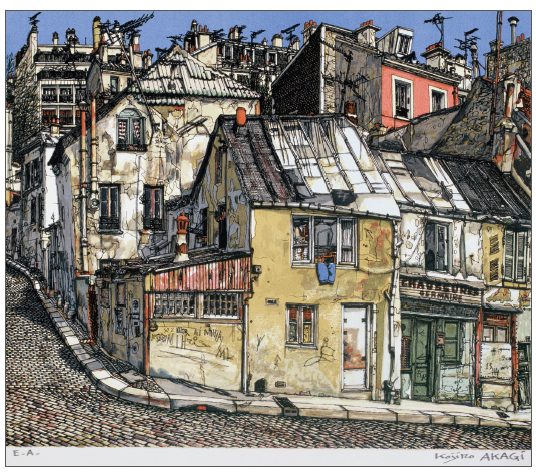Rue de la Mare à Belleville / Rue de la Mare, Belleville / ベルビルの沼通り
Dublin Core
Title
Rue de la Mare à Belleville / Rue de la Mare, Belleville / ベルビルの沼通り
Subject
Sérigraphie, Rue
Description
Au fond de l’illustration, on voit une petite butte d’une hauteur de 120 mètres qui offre un panorama sur Paris. A flanc de colline se trouvent plusieurs sources d’où, dès le 13e siècle, partaient des canalisations pour approvisionner Paris en eau. Bien avant J.-C., les Romains ont colonisé et occupé Paris. Ils avaient déjà construit, au sud de la ville, de grands aqueducs afin d’acheminer l’eau vers la capitale. Ces travaux colossaux prouvent combien ils maîtrisent les techniques d’acheminement de l’eau. Au pied de la colline se trouvait un bidonville. Il a été rasé dans les années 70 pour laisser place à une zone d’habitation HLM. Cette illustration a été réalisée juste avant que le quartier ne se modernise. D’ici, on entendait le bruit des machines à coudre provenant des bâtiments voisins, même si portes et fenêtres étaient fermées. Beaucoup d’ateliers clandestins de fabricants de vêtements employaient de la main-d’oeuvre immigrée à des salaires de misère. Ils fabriquaient ainsi à moindre coût, sans cotiser à la sécurité sociale et sans payer d’impôts. Les fournisseurs des grossistes du quartier du Sentier opéraient leurs transactions uniquement en espèces. A cette époque, une expression les définissait comme la «french confection», inspirée de la «french connexion», terme utilisé pour désigner les réseaux de dealers de drogues français. A partir des années 1990, une filière chinoise a inondé le marché français de textiles bon marché et la situation de l’industrie de la mode à Paris a complètement changé.
The low hill of Belleville, 120 meters above sea level, is behind this street and from there we can get a full view of Paris. There are many springs halfway up the hill and this water has been drawn via culverts since around the 13th century. However, the Romans, who occupied colonized it the Paris region before the Common Era, constructed a huge aqueduct which carried water from the south of Paris. It can still be seen today and we are impressed with such a massive structure. Water distribution was an important technology.The Rue de la Mare at the foot of the hill used to be a poor residential area with crowded housing but it was swept away in the 1970s and transformed into a district with a rows of tenement houses. This picture captures the period before it was completely demolished. Nearby the sound of sewing machines can be heard from behind closed windows and shutters. There were many clothing factories in dingy basements employing illegal immigrant workers. Cheap wages were paid and neither taxes nor social security contributions were paid so the costs were low, supplying wholesale merchants at Le Sentier. A new phrase French “confection syndicate” appeared, punning with the “French connection” drug syndicate. Since the 1990s, China has dominated this industry and has changed the aspect of the fashion industry of Paris.
後方はベルビルの海抜百二十メートルの小高い丘、パリを一望の開けた場所もある。水の湧き出す泉が、丘の中腹に何箇所もあって、もう十三世紀の頃からこの水を集めて、パリまで暗渠で引いて、利用していた。もっとも、紀元前からパリ地帯を占領し、植民地にしていたローマ人たちは、大きな水道橋工事をして、パリ南方から水を運ぶ工事もしていて、今でも見ることが出来て、巨大な工事に感心させられているのだから、水確保の工事は、重要な技術だったのだ。 その丘の麓にある沼通り、ゴミゴミした家並みの、貧しい住宅地だったが、一九七〇年代から一掃されて、公団住宅の立ち並ぶ地区に変貌してしまった。その取り壊される、最後の頃の絵である。近くで窓やシャッターを閉め切って、ミシンの音がする。不法の労働移民たちを集めて、闇の衣服製造地下工場が沢山あったのだ。安い賃金、税金、社会保障費を一切納めないのだから、安くできるわけで、サンチエ地区の現金卸問屋の供給源だった。麻薬組織のフレンチ・コネクションにかけて、フレンチ・コンフェクション組織という新語まで現れたほどだったが、一九九〇年代からは、東洋の中国全体が組織みたいなもので、国ぐるみで安い繊維製品を氾濫させて、パリの服飾業界の様相も変わってしまった。
Creator
Kojiro Akagi (1934-2021)
Date
Août 1981, August 1981
Rights
Fonds de dotation Kojiro AKAGI
Format
Sérigraphie, Atelier Del Arco, 100 tirages + 4 E.A. romain,
sur papier Arches 50 x 65 cm.
sur papier Arches 50 x 65 cm.
Type
Sérigraphie
Tags
Citation
Kojiro Akagi (1934-2021), “Rue de la Mare à Belleville / Rue de la Mare, Belleville / ベルビルの沼通り,” Kojiro Akagi - Fonds de dotation Kojiro AKAGI , accessed December 25, 2025, https://kojiroakagi.com/gallery/items/show/87.

